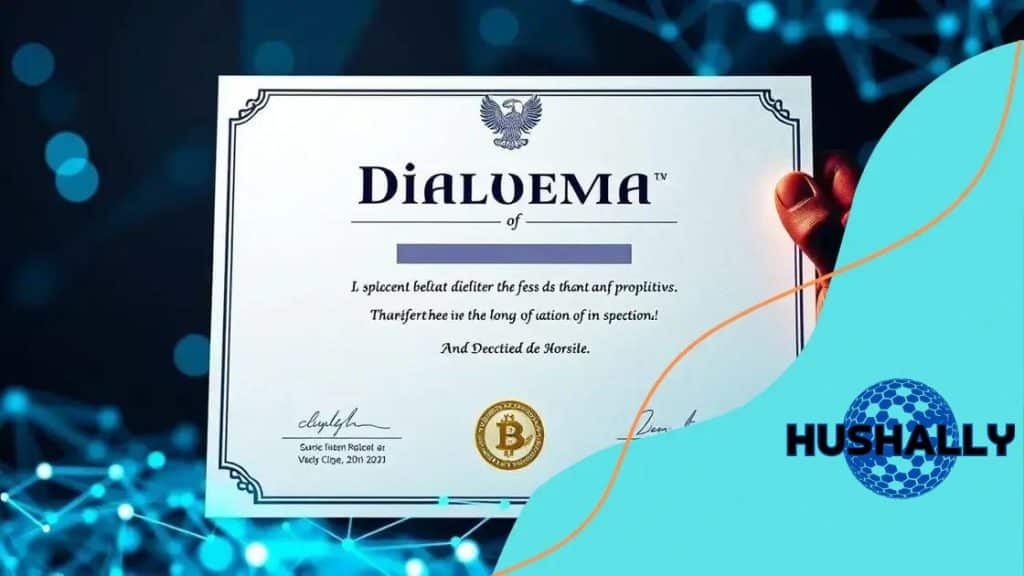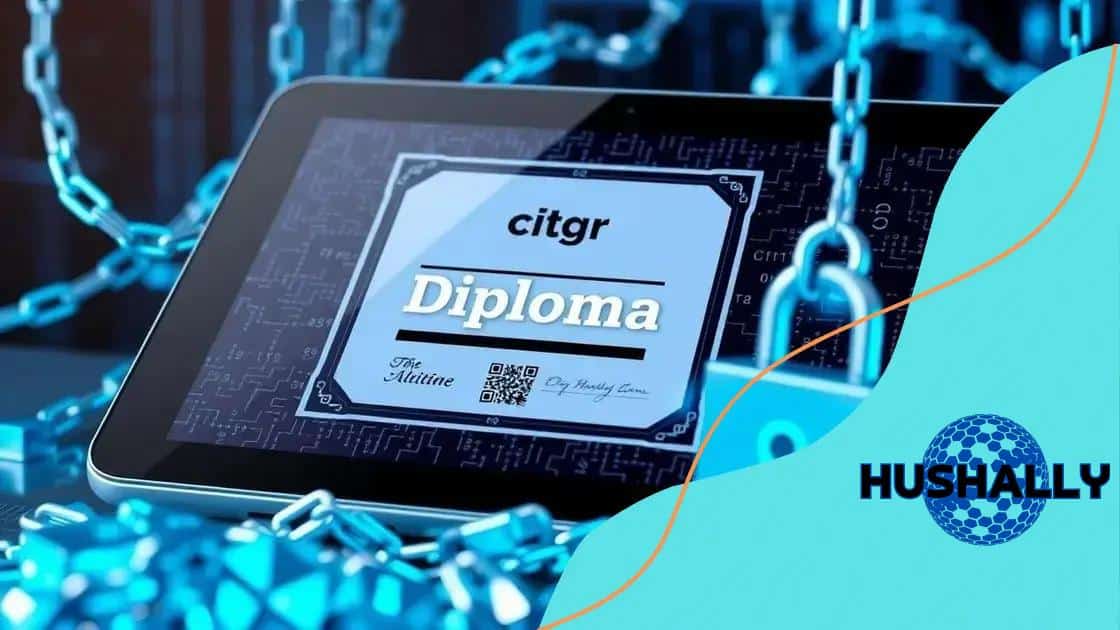Blockchain for secure diplomas: how it works

Blockchain for secure diplomas offers enhanced security, quick verification, and global recognition of educational credentials, revolutionizing the way institutions issue and validate diplomas.
Blockchain for secure diplomas is increasingly gaining traction as a method for safeguarding educational credentials. But how does it actually work? Let’s dive in and explore its potential benefits.
Understanding blockchain technology
Understanding blockchain technology is essential for anyone looking to grasp how it can impact various sectors, especially education. At its core, blockchain is a decentralized digital ledger that records transactions across many computers. This ensures that the recorded information is secure, transparent, and tamper-proof.
What is Blockchain?
Blockchain acts like a database that stores information in blocks. Each block holds a set of transactions, and once filled, it is added to the chain of previous blocks. This creates an unalterable record. The use of cryptography ensures that only authorized parties can access or modify the data.
Key Benefits of Blockchain
Some prominent benefits of blockchain technology include:
- Security: Data is protected through advanced encryption techniques.
- Transparency: All participants in the network can see the same information, eliminating doubts about authenticity.
- Efficiency: Traditional systems can be slow and bureaucratic. Blockchain speeds up processes by automating transactions.
- Decentralization: There is no central authority controlling the data, which reduces risks of manipulation.
As you can see, blockchain is a game changer. It offers efficiencies and verifiable security benefits that traditional systems often lack. Industries ranging from finance to healthcare are exploring its potential, but education is one of the most promising fields for its application.
In the education sector, the ability to securely store diplomas and certificates using blockchain ensures that employers can easily verify candidates’ qualifications. This not only streamlines the hiring process but also builds trust in academic achievements.
How Blockchain Works
The way blockchain functions is revolutionary. When a transaction is made, it gets grouped with others in a block. This block is then verified by network participants before being added to the existing chain. Each participant holds a copy of the entire chain, creating a shared history that can’t be altered without consensus from the majority.
This method of operation leads to a more trustworthy system where fraud becomes nearly impossible. As more institutions adopt this technology, we can expect to see a shift towards a more reliable credentialing process.
How blockchain secures educational credentials
How blockchain secures educational credentials is a crucial topic as institutions seek more reliable ways to verify student achievements. Blockchain technology offers a unique solution by creating an immutable record of each credential issued. This means that once a diploma or certificate is added to the blockchain, it cannot be altered or deleted.
The Verification Process
Verifying educational credentials can often be a time-consuming process. Traditional methods rely heavily on databases that can be hacked or manipulated. In contrast, with blockchain, any prospective employer or institution can quickly verify the authenticity of a diploma by accessing a decentralized ledger. This simplifies the verification process for everyone involved.
Benefits of Using Blockchain
Implementing blockchain for securing diplomas carries significant advantages:
- Enhanced security: Each entry is protected by cryptography, making fraud nearly impossible.
- Instantaneous access: Employers can instantly check a candidate’s qualifications without waiting for verification from institutions.
- Global acceptance: A blockchain record is universally accessible, meaning that diplomas can be verified anywhere in the world.
- Cost-effective: Over time, using blockchain reduces costs associated with verification and record-keeping.
This technology revolutionizes how educational credentials are perceived and verified. Imagine a world where each diploma holder has access to their digital credentials stored safely on the blockchain. This not only empowers graduates but also reassures employers of the authenticity of qualifications.
Moreover, institutions can avoid the risks associated with losing records. Traditionally, schools may face data loss due to natural disasters or cyberattacks. A blockchain system ensures data is securely stored and accessible at all times.
Case Studies and Real-World Applications
Several universities around the world are already exploring the capabilities of blockchain. They are issuing digital diplomas that employers can verify online. Such practical applications illustrate how blockchain can transform the landscape of education.
It’s important to understand that while the adoption of blockchain in education is still growing, the benefits are evident. As technology evolves, its integration could become a standard practice, leading to greater trust in educational achievements.
The benefits of using blockchain for diplomas

The benefits of using blockchain for diplomas are becoming increasingly clear as more institutions turn to this technology. Blockchain not only enhances security but also improves the overall process of issuing and verifying educational credentials.
Enhanced Security
One of the primary benefits of using blockchain is the heightened security it provides. Each diploma is encrypted and stored in a decentralized manner. This means that the information cannot be easily altered or deleted, reducing the risk of fraud significantly.
Streamlined Verification
Traditionally, verifying a diploma requires contacting institutions and waiting for responses. With blockchain, employers can instantly verify a candidate’s credentials through a secure system. This facilitates a faster hiring process and ensures accuracy.
Cost-Effective Solution
Over time, incorporating blockchain can be more cost-effective than traditional methods. Institutions can save on the costs associated with maintaining records and responding to verification requests. Additionally, reducing fraud also leads to savings by preventing the losses associated with credentialing errors.
Moreover, blockchain technology promotes a more transparent system. Since all transactions are recorded on a public ledger, it becomes easier for employers to trust the qualifications presented by job candidates. This transparency builds confidence and can lead to a more competitive job market.
Furthermore, the digital aspect of blockchain makes it highly accessible. Graduates can have their diplomas stored digitally, allowing them to share their credentials effortlessly with potential employers, regardless of their geographical location. This expands their opportunities on a global scale.
Future Implications
As the education sector shifts towards digitalization, the implementation of blockchain for diplomas is likely to become a standard practice. The growing acceptance of this technology can lead to a more unified approach toward credentialing across various institutions.
In time, we may witness a broader adoption, making blockchain an integral part of educational systems worldwide. The future of diplomas, secured by blockchain, points to an era of verification that is efficient, reliable, and beneficial for everyone involved.
Challenges of implementing blockchain
Challenges of implementing blockchain in the educational sector are significant, yet they offer valuable insights into the adoption of this technology. While blockchain has many benefits, its integration is not without hurdles that institutions must address.
Technical Complexity
One major challenge is the technical complexity of blockchain systems. Implementing a new technology requires extensive knowledge and expertise. Many educational institutions may not have the necessary technical skills in-house. This can lead to delays and increased costs, as hiring outside experts can be expensive.
Integration with Existing Systems
Another obstacle is the integration of blockchain with current systems. Educational institutions often rely on existing databases and infrastructure. Transitioning to a blockchain-based system may necessitate significant changes to these systems. This can be a daunting task and might disrupt the current workflow.
Moreover, the need for interoperability between different blockchain platforms complicates the situation. Institutions may choose different systems, and ensuring that these can communicate effectively is essential, yet challenging.
Regulatory Concerns
Regulatory issues also pose significant challenges. Privacy laws and regulations regarding data protection differ from one jurisdiction to another. Implementing blockchain must comply with these regulations, which can vary widely. Institutions must navigate these legal landscapes carefully to avoid potential penalties.
Costs of Transition
Although blockchain can lead to cost savings in the long run, the initial transition costs can be significant. Upgrading technology, training staff, and ensuring compliance can strain budgets. Some institutions may hesitate to invest heavily in blockchain if they are unsure of the immediate benefits.
Additionally, there may be pushback from stakeholders who are accustomed to traditional processes. Change can be unsettling, and it takes time to educate and gain support from all parties involved.
Building Consensus
Lastly, building consensus among stakeholders is crucial and can be a lengthy process. Faculty, administration, and other parties may have differing opinions about adopting blockchain. Engaging everyone in open discussions is necessary to ensure a smooth implementation.
In summary, while implementing blockchain in education presents several challenges, addressing these hurdles can ultimately lead to more secure and efficient systems for verifying diplomas and credentials.
Future of blockchain in education
Future of blockchain in education holds great promise as more educational institutions explore its potential. This innovative technology is set to transform how credentials are verified, stored, and shared across the globe.
Increased Adoption
As universities and colleges become more aware of the benefits of blockchain, we can expect to see increased adoption. Institutions will likely start issuing digital diplomas on the blockchain. This practice ensures that credentials are secure and easily verifiable.
Improved Student Experience
The future will also see improved student experiences. Instead of worrying about lost diplomas, students will have digital access to their achievements. This accessibility enables them to share credentials with prospective employers quickly and efficiently.
- Convenience: Instant access to digital diplomas saves time for both students and employers.
- Transparency: Blockchain provides a transparent record for all stakeholders.
- Global Recognition: Diplomas can be verified worldwide, opening doors for job opportunities.
Collaboration Across Institutions
Integration of blockchain in education may also lead to greater collaboration among institutions. Schools could form partnerships to create a unified blockchain system. This would further streamline the verification process, ensuring that students’ credentials are universally accepted.
Such collaboration can enhance the reputation of participating institutions and promote trust in the education system. Students will benefit from a transparent environment where their qualifications are recognized globally.
Regulatory Evolution
As blockchain becomes more prevalent, regulatory frameworks will likely evolve. Governments and educational bodies will need to create guidelines to ensure data protection and compliance with privacy laws. This regulatory evolution will be crucial to protecting students’ information while maximizing the benefits of blockchain.
Innovative Learning Solutions
Finally, blockchain can introduce innovative learning solutions. For instance, some institutions are experimenting with decentralized finance (DeFi) to provide funding for students. This financing model could serve as a new way for students to manage tuition fees and other educational expenses.
As more research and development occur in this area, we may see a blend of traditional education with new technologies, fostering a more dynamic learning environment.
In conclusion, the future of blockchain in education is filled with potential. As schools begin to adopt this technology, we can expect to see more secure and efficient ways to verify and store diplomas. This shift can lead to a better experience for students, employers, and institutions alike. Challenges will arise, but with collaboration and innovation, blockchain is poised to revolutionize the educational landscape, making education more accessible and trustworthy for everyone.
FAQ – Frequently Asked Questions about Blockchain in Education
What is blockchain?
Blockchain is a decentralized digital ledger that securely records transactions across multiple computers, ensuring data integrity and transparency.
How does blockchain enhance security for diplomas?
By encrypting data and storing it on a decentralized network, blockchain makes it extremely difficult for anyone to alter or counterfeit educational credentials.
What are the benefits of using blockchain for verifying diplomas?
The benefits include quick verification, reduced costs for institutions, enhanced accessibility for students, and increased trust from employers.
What challenges do institutions face when implementing blockchain?
Challenges include technical complexity, integration with existing systems, regulatory concerns, and the initial costs of transitioning to blockchain.





